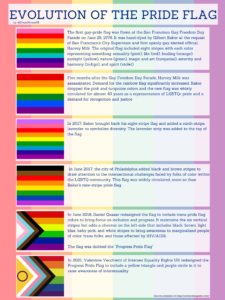Heading Title
Five Important LGBTQ+ Dates in June Worth Celebrating
By: @DreasHouse28
TW: extreme homophobia, extreme violence, race violence, mass shooting, domestic terrorism (US)
June is globally recognized as LGBTQ+ Pride Month. It’s a month-long celebration of queer progress, successes, and aspirations. Pride Month is different from LGBT History Month, which focuses on the history of gay rights and related civil rights movements. LGBT History Month is only celebrated by a dozen or so countries and throughout the year. For example, LGBT History Month occurs every February for England, Scotland, Wales, and Northern Ireland; April for Italy; May for Cuba and Germany; and October for Australia, Canada, and the United States.
June’s Pride Month, however, is celebrated globally by many countries, and these Pride celebrations are meant to reflect on our past, encourage introspection of the present, and consider how we want to shape our future.
Below are five important LGBTQ+ dates in June worth celebrating.
June 1: Pride Month Kick-Off
June 1st is globally recognized as the global kick-off day of Pride Month celebrations around the world.
After the Stonewall Uprising in 1969 (see June 28), queer folks began celebrating Pride during the month of June, as close to the Stonewall anniversary as possible. The celebrations began as week-long celebrations that were uncoordinated across communities with everyone doing their own thing at some point at the end of June. With the advancement of communication methods, communities were able to organize pride events better and share celebration ideas. Eventually, the entire month of June became Pride Month, not just the end of the month. It was unofficially celebrated for thirty years in the United States before the federal government recognized it as a celebratory month.
The United States held its first Pride march (now often called “parade” or “celebration”) on June 28, 1970. Pride Month wasn’t officially recognized in the United States until June 1999 when then-president Bill Clinton declared the month “Gay and Lesbian Pride Month.” In 2011, then-president Barack Obama expanded the declaration to be “LGBT Pride Month.” Ten years later, in 2021, current president Joe Biden expanded the declaration even more to be “LGBTQ+ Pride Month.”
The United Kingdom held its first Pride march in London on July 1, 1972. Local pride activists chose this date because it was the nearest Saturday to the anniversary of the Stonewall riots. London later moved its marches to the month of June. The United Kingdom passed section 28 of the Local Government Act in 1988 that prohibited the promotion of homosexuality, and this included severely limiting the ability to host Pride celebrations. At the beginning of the 21st Century, Section 28 was repealed in Scotland in 2000 and England and Wales in 2003. In 2022, the mayor of London agreed to a five-year contract to run annual Pride events from 2023-2027 with a commitment to create a “clear and definitive anti-racism plan.” This commitment to support the queer and minority communities has created a safe place for pride celebrations to occur with the support of their governing body.
June 12: Pulse Remembrance
TW: extreme homophobia, extreme violence, race violence, mass shooting domestic terrorism (US)
On June 12, 2016, a domestic terrorist orchestrated and carried out a mass shooting at Pulse nightclub in Orlando, Florida, killing 49 LGBTQ+ folks and wounding 53 more. Victims ranged in age from 21-50, most of whom were of Latina/o/e/x descent, as the club was hosting a Latin Pride night.
The U.S. Government recognized this massacre was (and still is) the deadliest violence against LGBTQ+ people in the United States. In addition, the Pulse nightclub massacre is considered the second deadliest mass shooting in modern American history (the first is the 2017 Las Vegas music festival shooting).
June 12th recognizes and pays respect to the victims, both their blood and chosen families, and the countless first responders and healthcare professionals who helped those affected by the Pulse massacre. The day also provides a broader recognition to those in the LGBTQ+ community at risk of homophobic attacks.
June 17: Federal Benefits in the U.S.
On June 17, 2009, then-president Barack Obama signed a referendum allowing same-sex partners of federal employees to receive benefits. The referendum did not allow for full health coverage, but it was widely recognized as a major step in his campaign to improve gay rights in the United States.
June 25: Birth of the Pride Flag

The first gay-pride flag was flown at the San Francisco Gay Freedom Day Parade on June 25, 1978. The flag was hand-dyed by Gilbert Baker at the request of San Francisco’s City Supervisor and first openly gay elected official, Harvey Milk. The original flag included eight stripes with each color representing something:
Hot pink: sexuality
Red: life
Orange: healing
Yellow: sunlight
Green: nature
Turquoise: magic and art
Indigo/blue: serenity and harmony
Violet: spirit
Five months after the Gay Freedom Day Parade, San Francisco City Supervisor Harvey Milk was assassinated and demand for the rainbow flag significantly increased. Over the next year, Baker dropped the pink and turquoise colors (mostly due to rarity of fabric), and the new six-stripe flag was widely circulated for almost 40 years as a representation of LGBTQ+ pride and a demand for recognition and justice. This six-stripe flag became widely accepted as the umbrella pride flag in addition to other niche or lesser known symbols representing various aspects of the queer community.
In 2017, Baker brought back his eight-stripe flag and added a ninth-stripe, lavender, to symbolize diversity.
Shortly after, the city of Philadelphia added black and brown stripes to draw attention to the intersectional challenges faced by folks of color within the LGBTQ community. This flag was widely circulated, more so than Baker’s nine-stripe pride flag.
In June 2018, Daniel Quasar redesigned the flag to include trans pride flag colors to bring focus on inclusion and progress. It maintains the six vertical stripes but adds a chevron on the left-side that includes black, brown, light blue, baby pink, and white stripes to bring awareness to marginalized people of color, trans folks, and those affected by HIV/AIDS. The flag was dubbed the “Progress Pride Flag.”
In 2021, Valentine Vecchietti of Intersex Equality Rights UK redesigned the Progress Pride Flag to include a yellow triangle and purple circle in it to raise awareness of intersexuality.
June 25th is recognized as the birth of the original LGBTQ+ rainbow flag. Though queer folks are encouraged to fly their queer flags every day, many fly their flags just a little bit higher on June 25th.
June 26: DOMA Declared Unconstitutional
On June 26, 2013, the U.S. Supreme Court declared the 1996 Defense of Marriage Act (DOMA) as unconstitutional, ruling that DOMA violated the rights of gays and lesbians under the U.S. Constitution’s Equal Protection clause.
The DOMA was passed in 1996 and it, in part, prevented the government from over-ruling state’s recognition of same-sex marriages for the purpose of federal laws and programs. This meant that from 1996-2013, if an individual state did not recognize a same-sex couple’s marriage as legal, that couple could not receive federal benefits as a married couple in that state. Examples of federal programs include healthcare benefits, hospital visitation rights, military and social security benefits, immigration protections for binational couples, and joint income tax filing and exemption benefits. It limited the rights of the federal government and placed the states’ rights in higher authority over the federal government when regarding the definition and recognition of marriages.
The overturning of Section 3 of the DOMA required the federal government to recognize same-sex marriages, thus providing access to federal laws and programs to same-sex couples, regardless of individual states’ recognition and performance of same-sex marriages. The overturning did NOT require states to recognize and perform same-sex marriages. That came two years later.
June 26: Right to Marry in the United States
On June 26, 2015, the U.S. Supreme Court ruled that same-sex couples are guaranteed the fundamental right to marry. The justices cited the Fourteenth Amendment of the U.S. Constitution that states no person shall be denied “the equal protection of the laws” (Equal Protection Clause) and that no person shall be denied “life, liberty, or property, without due process of law” (Due Process Clause). This ruling required all U.S. states, districts, and Insular territories to perform and recognize same-sex marriages.
The New York Times reported that a companion survey to the U.S. Census recorded about 720,000 married same-sex couples in the United States as of December 2022.
For reference, the United Kingdom has recognized and performed same-sex marriages since 2014 (England, Wales, and Scotland) and 2020 (Northern Ireland). The British Overseas Territories have legalized same-sex marriage in only eight of the fourteen territories, passage ranging from 2014 to 2022.
June 28: Christopher Street Day (Stonewall Riots)
June 28, 1969, is a date that will live in LGBTQ+ infamy. It was the night New York City police raided the Stonewall Inn, an event that led to six days of riots and demonstrations that ultimately launched the gay rights movement in the United States, United Kingdom, and other parts of the world. The events have been referred to as the Stonewall Uprising, a term used to encapsulate the raid and the riots that immediately followed the event on Christopher Street where the Stonewall Inn is located.
According to the Library of Congress, the Stonewall Inn raid “was not the first time police raided a gay bar, and it was not the first time LGBTQ+ people fought back, but the events that would unfold over the next six days would fundamentally change the nature of LGBTQ+ activism in the United States.” Survivors of the raid, participants in the riots, and activists took to the streets to demonstrate against the abuse and discrimination queer folks faced for centuries.
Activists and survivors formed the Christopher Street Liberation Day Committee to organize a pride week and celebration, which culminated with the first Pride march (now often called “parades”) happening on June 28, 1970 – exactly one year after the initial raid.
Throughout the entire month of June, but especially on June 28th, we celebrate what it means to be queer and we pay respect to not only those who were directly affected by the Stonewall Uprising, but also to those who so courageously fought for LGBTQ+ rights over the next 50+ years.
Concluding Thoughts
While our queer histories and experiences are often clouded with tragedy, those same histories and experiences are also multi-layered with histories and experiences that are worthy of celebration. They are meant for us to reflect on our past, introspect on our present, and shape our future.
We queers want to be in control of how our histories are written. Tweet us your reasons for being prideful. We’d love to hear your queer stories.
Sources:
College of Coastal Georgia Library. “Timeline of LGBT rights in the U.S.” https://libguides.ccga.edu
Dryden, S. “A short history of LGBT rights in the UK.” https://www.bl.uk
GLAAD. “Frequently asked questions: Defense of Marriage Act (DOMA).” https://www.glaad.org
New York Times. “Same-sex couple households in U.S. surpass one million.” https://www.nytimes.com
One Pulse Foundation. “About onePULSE Foundation.” https://onepulsefoundation.org
Seattle Pride. “2023 LGBTQIA+ holidays & remembrances.” https://seattlepride.org
Merritt, E. C.. “Pride in the UK: From its roots to today.” U.K. Parliament https://lordslibrary.parliament.uk
Masci, D., Podrebarac, S. and Lipka, M. “Same-Sex marriage around the world.” The Pew Research Center. https://www.pewresearch.org
United States Library of Congress. “Today in history: June 28” https://www.loc.gov
United States White House. “Fact sheet: The Biden-Harris Administration champions LGBTQ+ equality and marks pride month” https://www.whitehouse.gov
Wallenfeldt, J. “Why is Pride Month celebrated in June” https://www.britannica.com
